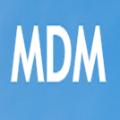A general form of codebook design for code-domain non-orthogonal multiple access (CD-NOMA) can be considered equivalent to a constellation design for multi-user multi-dimensional modulation (MU-MDM). Motivated by recent works on deep learning (DL)-based design of MDM, we propose new architectures for autoencoder and the underlying training methodology that aim at joint optimization of resource mapping and a constellation design with bit-to-symbol mapping, hopefully approaching a bit error rate (BER) performance of the equivalent single-user MDM (SU-MDM) model. The novelty and contribution of the paper lies in the proposed architectures of autoencoder and the underlying training framework for optimum codeword design for CD-NOMA, which without knowing other-user symbols, approaches the performance of SU-MDM with the same spectral efficiency. It includes the trainable architectures of DL-based designs for SU-MDM and MU-MDM, which can be equivalently compared to each other. They are implemented to demonstrate that the proposed design for MU-MDM can achieve the BER performance of DL-based single-user codebook design within 0.3 dB in the additive white Gaussian noise channel, thus serving as the best existing design that can be realized with its low-complex decoder.
翻译:可用于非正反调多功能代码的代码簿设计的一般形式(CD-NOMA)可被视为等同于多用户多维调制(MMM-MMMM)的星座设计。由于最近关于基于MDM的深层学习设计(DL)的著作,我们提议了自动编码器的新结构以及基本的培训方法,目的是联合优化资源绘图和带有比特比比符号绘图的星座设计,希望能够接近同等的单一用户MDM(SU-MDMM)模型的略微误差率(BER)性能。本文的新颖性和贡献在于拟议的自动编码器结构以及光盘-NOMA最佳编码设计的基本培训框架,这些结构在没有了解其他用户符号的情况下,将SU-MDM的性能与光谱效率相近,其中包括SUMMMM和MU-MMMMMMMMMMMMMMM等的可培训的DB型设计,它们可以表明MUM-MDM-MDM公司的拟议设计设计比略差,因此能够实现现有DMB号标准标准标准中最佳设计标准,从而实现DBMLARIB系统现有标准。




